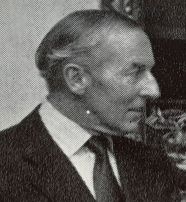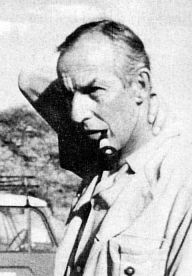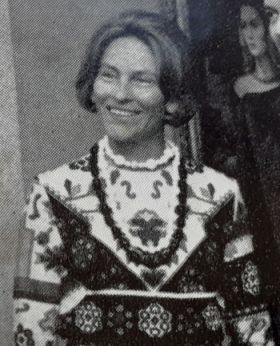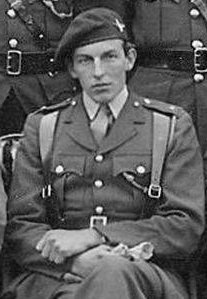View entry
Name: TATHAM-WARTER, Allison Digby DSO (Major)




Nee: son of Kathleen Maude Tatham-Warter
Birth Date: 21 May 1917 Atcham, Shropshire
Death Date: 21 March 1993 Nanyuki
First Date: 1946
Profession: Game hunter and safari operator, farmer
Area: Eburru, Nanyuki
Married: 1949 Mary Jane Boyd b. 1930, d. 2 May 2021 Nanyuki (dau. of Roderick Bulteel Boyd and granddau. of the Earl of Wilton)
Children: Caroline; dau. Jo; Belinda Rose 'Binny'
Book Reference: Best, Rhino Link 3, Hut, Wolseley-Lewis, Obituary
School: Wellington, Sandhurst
General Information:
Rhino Link 3 - The world at large remembers Digby for the courage and individual style he displayed at Arnhem when commanding a company of 2 Para, later recorded in the film 'A Bridge Too Far' with much artistic licence and insufficient recognition of the incredible bravery which earned him the DSO (many thought it should have been the VC). Many Club members, however, will remember him best from his service in 5 KAR in Kenya from 1946-48, when he formed a pack of hounds and made a determined but unsuccessful attempt to introduce pig-sticking in Nanyuki; and from his time with the Mounted Section of the Kenya Police Reserve which he formed and commanded with much success during Mau Mau.
Digby was in many ways a 'larger than life' character, outspoken and sometimes irascible, yet the most loyal of friends with the warmest of natures. Once the Kenya emergency was over, he concentrated on the farming life at Eburru which had first drawn him to Kenya as well as running, with his lovely wife Jane, superb and immensely successful photographic safaris. As soldier, farmer, sportsman, safari guide, host, and in later times, amateur carpenter, Digby excelled.
Telegraph - 30/3/1993 - Long obituary on file
Formerly of the Parachute Regt., who had distinguished himself at Arnhem by leading a bayonet charge in a captured bowler hat, with an umbrella to protect him against mortar bombs.
Wikipedia: When the Second World War broke out, Digby was not initially sent to fight in Europe. His sister Kit served in the Western Desert Campaign and was awarded the French Croix de guerre while serving with the Hadfield-Spears Unit. Upon hearing of his brother John's death at the Second Battle of El Alamein in late 1942 with the 2nd Dragoon Guards, The Queen's Bays, Digby volunteered for the airborne forces and transferred to the Parachute Regiment. He was appointed as the company commander of A Company of the 2nd Parachute Battalion, part of the 1st Parachute Brigade of the 1st Airborne Division. He was stationed in Grantham, Lincolnshire during training. His tiger hunting exploits were well known, and his reputation was enhanced as he was able to obtain the use of an American Dakota aeroplane in which he flew all the company officers in the camp to London for a party at the Ritz.
A Company was then chosen by the battalion's commanding officer, Lieutenant Colonel John Dutton Frost, to lead the 2nd Parachute Battalion in the Battle of Arnhem, part of Operation Market Garden, because of Digby's reputation of being an aggressive commander. In preparation Digby, concerned about the unreliability of radios, educated his men on how to use bugle calls that had been used during the Napoleonic Wars for communication in case the radios failed. He also took an umbrella with his kit as a means of identification because he had trouble remembering passwords and felt that anyone who saw him with it would think that "only a bloody fool of an Englishman" would carry an umbrella into battle.
A Company were dropped away from the target of Arnhem Bridge and had to go through Arnhem where the streets were blocked by German forces. Digby led his men through the back gardens of nearby houses instead of attempting to advance through the streets and thus avoided the Germans.Digby and A Company managed to travel 8 miles in 7 hours while also taking prisoner 150 German soldiers including members of the SS. During the battle, Digby wore his maroon beret instead of a helmet and waved his umbrella while walking about the defences despite heavy mortar fire. When the Germans started using tanks to cross the bridge, Digby led a bayonet charge against them wearing a bowler hat. He later disabled a German armoured car with his umbrella, incapacitating the driver by shoving the umbrella through the car's observational slit and poking the driver in the eye.
Digby then noticed the chaplain pinned down by enemy fire while trying to cross the street to get to injured soldiers. Digby got to him and said "Don't worry about the bullets, I've got an umbrella". He then escorted the chaplain across the street under his umbrella. When he returned to the front line, one of his fellow officers said about his umbrella that "that thing won't do you any good", to which Digby replied "Oh my goodness Pat, but what if it rains?"Digby was later injured by shrapnel, which also cut open the rear of his trousers but continued to fight until A Company had run out of ammunition. Despite the radios being unreliable as Digby had predicted and the bugle calls being used most in the battle, the message "out of ammo, God save The King" was radioed out before Digby was captured.
Because of his injury, Digby was sent to St Elizabeth's Hospital but escaped out of a window with his second in command Captain Tony Frank, when the German nurses had left them alone. After creating an escape compass from buttons on his uniform, Digby and Frank headed towards Mariendaal. Upon arriving, they were hidden by a Dutch woman who spoke no English before being put in contact with her neighbour. He disguised them as painters and moved them to Derk Wildeboer's house. Wildeboer was a local leader of the Dutch Resistance in Ede. They then met Menno de Nooy of the Dutch Resistance who gave them a bicycle. Wildeboer had a fake Dutch identity card made for Digby to allow him to pose as Peter Jensen, a deaf-mute son of a lawyer.Digby used the bicycle to visit fellow soldiers in hiding and the Germans did not recognise him despite him helping to push a Nazi staff car out of a ditch and German soldiers being billeted in the same house that he was staying in. Digby then gathered 150 escaped soldiers to head towards the front line. This was known as Operation Pegasus. Digby and the soldiers cycled to the Rhine and Digby flashed a V for Victory sign using Morse Code with his torch. Members of XXX Corps then ferried them across the river. Upon return to the United Kingdom, Digby was awarded the Distinguished Service Order. He also wrote a report on the Battle of Arnhem Bridge that resulted in Lieutenant Jack Grayburn's posthumously receiving a promotion to captain and being awarded the Victoria Cross.
After the war ended, Digby served in British-controlled Mandatory Palestine before being appointed to the 5th King's African Rifles in British Kenya in 1946, where he also bought two estates in Eburru and Nanyuki. During the Mau Mau Uprising, Digby raised a volunteer mounted police force at his own expense and led them into battle against the Mau Mau. He then retired to run his estates. He also created the concept of the modern safari where animals would be photographed rather than hunted. He supported racial reconciliation and believed Africans had the right to self-government, this belief made him somewhat of an outlier within Kenya's European community. Tatham-Warter was "outspokenly sympathetic" to African nationalism and in particular to Kikuyu concerns about land ownership. During Kenyan independence, it is reported that the British Defence staff told the British High Commissioner to "look after Tatham-Warter".
Wikipedia: When the Second World War broke out, Digby was not initially sent to fight in Europe. His sister Kit served in the Western Desert Campaign and was awarded the French Croix de guerre while serving with the Hadfield-Spears Unit. Upon hearing of his brother John's death at the Second Battle of El Alamein in late 1942 with the 2nd Dragoon Guards, The Queen's Bays, Digby volunteered for the airborne forces and transferred to the Parachute Regiment. He was appointed as the company commander of A Company of the 2nd Parachute Battalion, part of the 1st Parachute Brigade of the 1st Airborne Division. He was stationed in Grantham, Lincolnshire during training. His tiger hunting exploits were well known, and his reputation was enhanced as he was able to obtain the use of an American Dakota aeroplane in which he flew all the company officers in the camp to London for a party at the Ritz.
A Company was then chosen by the battalion's commanding officer, Lieutenant Colonel John Dutton Frost, to lead the 2nd Parachute Battalion in the Battle of Arnhem, part of Operation Market Garden, because of Digby's reputation of being an aggressive commander. In preparation Digby, concerned about the unreliability of radios, educated his men on how to use bugle calls that had been used during the Napoleonic Wars for communication in case the radios failed. He also took an umbrella with his kit as a means of identification because he had trouble remembering passwords and felt that anyone who saw him with it would think that "only a bloody fool of an Englishman" would carry an umbrella into battle.
A Company were dropped away from the target of Arnhem Bridge and had to go through Arnhem where the streets were blocked by German forces. Digby led his men through the back gardens of nearby houses instead of attempting to advance through the streets and thus avoided the Germans.Digby and A Company managed to travel 8 miles in 7 hours while also taking prisoner 150 German soldiers including members of the SS. During the battle, Digby wore his maroon beret instead of a helmet and waved his umbrella while walking about the defences despite heavy mortar fire. When the Germans started using tanks to cross the bridge, Digby led a bayonet charge against them wearing a bowler hat. He later disabled a German armoured car with his umbrella, incapacitating the driver by shoving the umbrella through the car's observational slit and poking the driver in the eye.
Digby then noticed the chaplain pinned down by enemy fire while trying to cross the street to get to injured soldiers. Digby got to him and said "Don't worry about the bullets, I've got an umbrella". He then escorted the chaplain across the street under his umbrella. When he returned to the front line, one of his fellow officers said about his umbrella that "that thing won't do you any good", to which Digby replied "Oh my goodness Pat, but what if it rains?"Digby was later injured by shrapnel, which also cut open the rear of his trousers but continued to fight until A Company had run out of ammunition. Despite the radios being unreliable as Digby had predicted and the bugle calls being used most in the battle, the message "out of ammo, God save The King" was radioed out before Digby was captured.
Because of his injury, Digby was sent to St Elizabeth's Hospital but escaped out of a window with his second in command Captain Tony Frank, when the German nurses had left them alone. After creating an escape compass from buttons on his uniform, Digby and Frank headed towards Mariendaal. Upon arriving, they were hidden by a Dutch woman who spoke no English before being put in contact with her neighbour. He disguised them as painters and moved them to Derk Wildeboer's house. Wildeboer was a local leader of the Dutch Resistance in Ede. They then met Menno de Nooy of the Dutch Resistance who gave them a bicycle. Wildeboer had a fake Dutch identity card made for Digby to allow him to pose as Peter Jensen, a deaf-mute son of a lawyer.Digby used the bicycle to visit fellow soldiers in hiding and the Germans did not recognise him despite him helping to push a Nazi staff car out of a ditch and German soldiers being billeted in the same house that he was staying in. Digby then gathered 150 escaped soldiers to head towards the front line. This was known as Operation Pegasus. Digby and the soldiers cycled to the Rhine and Digby flashed a V for Victory sign using Morse Code with his torch. Members of XXX Corps then ferried them across the river. Upon return to the United Kingdom, Digby was awarded the Distinguished Service Order. He also wrote a report on the Battle of Arnhem Bridge that resulted in Lieutenant Jack Grayburn's posthumously receiving a promotion to captain and being awarded the Victoria Cross.
After the war ended, Digby served in British-controlled Mandatory Palestine before being appointed to the 5th King's African Rifles in British Kenya in 1946, where he also bought two estates in Eburru and Nanyuki. During the Mau Mau Uprising, Digby raised a volunteer mounted police force at his own expense and led them into battle against the Mau Mau. He then retired to run his estates. He also created the concept of the modern safari where animals would be photographed rather than hunted. He supported racial reconciliation and believed Africans had the right to self-government, this belief made him somewhat of an outlier within Kenya's European community. Tatham-Warter was "outspokenly sympathetic" to African nationalism and in particular to Kikuyu concerns about land ownership. During Kenyan independence, it is reported that the British Defence staff told the British High Commissioner to "look after Tatham-Warter".
